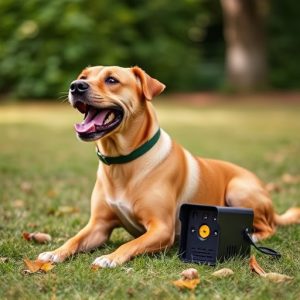Unveiling Electronic Barking Dog Alarms: Comprehensive Guide
Electronic barking dog alarms offer a high-tech solution for home security and noise control. These…….
Electronic barking dog alarms offer a high-tech solution for home security and noise control. These devices mimic real dog barks through motion sensors, emitting non-lethal sounds to deter intruders. Customizable settings, from volume to app control, enhance their effectiveness in various environments, making them an eco-friendly alternative to traditional alarm systems. When choosing, consider the device's purpose (training or deterrence), sound intensity, and sensitivity for optimal results, especially in larger spaces or outdoor areas.
Unleash a new level of peace with an electronic barking dog alarm—a pet-friendly solution to excessive canine noise. This comprehensive guide explores the ins and outs of these innovative devices, from their inner workings to training tips. Discover how they use sound and vibration to moderate barking without fear or harm, offering benefits like improved sleep and community harmony. We’ll break down types, features, and real-world applications, empowering you to choose and implement an effective electronic barking dog alarm for a quieter, more balanced home environment.
Understanding Electronic Barking Dog Alarms: A Comprehensive Overview
Electronic barking dog alarms are innovative devices designed to mimic the sound of a dog’s bark, deterring potential intruders. These alarms utilize technology to replicate the high-pitched barks that often signal distress or alertness in real dogs. By emitting these sounds, they create an illusion of a protective canine presence, even when there isn’t one. Understanding how these alarms work and their various applications is key to harnessing their effectiveness as a security measure.
These devices are typically activated by motion sensors or security systems, triggered when someone enters a defined area. The alarm sounds can vary from realistic dog barks to more general alerts, depending on the model. They are not only useful for homeowners but also for businesses seeking additional security. With their non-lethal approach, electronic barking dog alarms offer a humane alternative to traditional animal-based deterrents while still providing a powerful deterrent against unwanted intruders.
How These Devices Work and Their Key Components
Electronic barking dog alarms are designed to mimic the sound of a dog’s bark, deterring intruders or unwanted visitors. These devices typically work by using a combination of sensors and electronic circuitry to detect motion or vibration and trigger the alarm sound. When activated, the alarm emits a high-pitched, repetitive bark that can be customized in some models to adjust volume or frequency.
The key components of an electronic barking dog alarm include a sensor (often a passive infrared sensor or a vibration sensor), a circuit board with integrated chips for processing signals and generating the alarm sound, and a speaker to produce the audio. Some advanced models may also feature adjustable sensitivity settings, night mode for reduced false triggers during quieter hours, and even app control for remote monitoring and activation. These features enhance the effectiveness and convenience of using such devices as home security measures.
Benefits of Using an Electronic Barking Dog Alarm
Using an electronic barking dog alarm offers numerous advantages for pet owners and neighbors alike. One of the primary benefits is its effectiveness in deterring unwanted attention from your property. Unlike traditional barking, which can be unpredictable and vary in intensity, these alarms provide a consistent and controlled response to potential intruders. The device emits a realistic electronic bark that mimics the sound of a real dog, startling would-be intruders and giving you precious time to respond.
Additionally, electronic barking dog alarms are convenient and easy to use. They can be activated remotely via smartphone apps or motion sensors, allowing for quick adjustments during everyday activities. This flexibility ensures that you have complete control over when the alarm sounds, enhancing your peace of mind. Moreover, these devices are environmentally friendly, as they do not rely on excessive noise pollution, making them a preferred choice for areas with strict noise regulations.
Types and Features to Consider Before Purchase
When considering an electronic barking dog alarm, it’s important to understand the variety of options available, each with unique features catering to different needs. These devices typically fall into two main types: those designed for training and those aimed at deterring intruders. The former often employs ultrasonic sounds or vibrations to discourage unwanted behavior without causing harm, while the latter focuses on emitting loud, unpleasant noises to startle potential threats.
Before making a purchase, look out for features like sound intensity adjustment, sensitivity settings, and activation modes (motion-activated, sound-activated, or both). Some models also offer customizable barking sounds or prerecorded messages, adding versatility to their functionality. Additionally, consider the device’s range and battery life, especially if you’re looking to use it in larger areas or outdoor spaces.
Effective Use Cases and Tips for Training Your Pet
An electronic barking dog alarm can be a valuable tool for pet owners dealing with persistent barking issues, offering a humane and effective solution to train your pet. It mimics the sound of a bark but without the negative reinforcement often associated with traditional punishment methods. Use cases vary from apartment dwellers aiming to prevent excessive noise disturbances to outdoor spaces where a dog’s bark may go unnoticed.
Training tips include setting clear boundaries and consistent commands, using the alarm as a positive reinforcement for desired behavior (silence), and gradually increasing the sensitivity of the device to match your pet’s barking patterns. Regular practice sessions are key; reward quiet periods with affection or treats to reinforce the learning process. Remember, patience is crucial during training, as every dog learns at its own pace.


